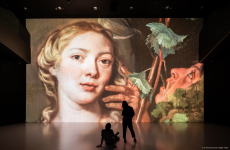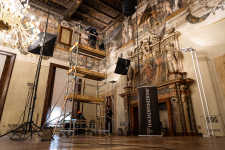With museums still closed this year in physical reality, the Refectory of the Convent of Santa Maria delle Grazie in Milan, home of the Last Supper of Leonardo da Vinci, offers a virtual visit to anyone interested in discovering it.
In celebration of the Easter holiday, Haltadefinizione and the Museums of the Lombardy Region have installed a theme-based virtual visit that also promises the discovery of details and hidden curiosities in the supper table setting that are nearly invisible to the ordinary observer.
On the website of the Museum of the Cenacolo Vinciano (the Museum of the Last Supper), visitors can navigate around this most famous work and dive into its details like never before.
The Jewish Passover, Pesach, includes a seder, a ritual supper that recalls the life of the Jewish people before the flight from Egypt. That is the supper that Jesus is sharing with the Apostles. The traditional menu for a Pesach includes bitter herbs, unleavened bread, charoset, roast lamb and wine. The supper in Leonardo’s painting is quite different, in fact showing the foods of its own time. We invite you to take a close look at them and to observe Leonardo’s skillful depiction of light and reflection.
The opportunity for this close examination is the result of the ultra-high definition digital acquistion and display technology developed by Haltadefinizione. This project is part of the museum’s commitment to use digital communications with Leonardo’s masterpiece. A new website, an app for visitors with a guided tour, available for IOS and Android, and Facebook (Museo del Cenacolo Vinciano) and Instagram (Cenacolo_Vinciano) pages, have all been put in place in the last two years.
“A digital copy can never replace the deep emotions of standing in front of a work of art and taking it all in, face to face, its physical dimensions and its setting,” says Emanuela Daffra, Director of the Museums of the Region of Lombardy. “But this technology offers another previously impossible experience, that of seeing a work up close, much closer than you could ever get to a painting if you were concerned about protecting it. You can see it from very close, much closer than is possible with the human eye. This allows us to discover secrets of technical execution and details that usually pass unobserved. Overall, digital technology enriches our experience.”
Among the many new projects at Haltadefinizione, there is an avant-garde digital viewing platform. This tool will amplify the user’s experience with multimedia story telling that can deepen ones vision of a work of art through personalized pathways, supported by the powerful ultra-high definition Gigapixel images themselves.
“We are very pleased to be working with with the Museums of Lombardy and the Museum of the Last Supper. In 2007, Haltadevinizione’s second digital acquisition of a major work was done for the Last Supper. It took 16.1 Gigapixels and for many years it remained the single largest digital image ever made in the world,” says Luca Ponzio, the founder of Haltadefinizione. “This new initiative dedicated to the Last Supper shows how we hope to broaden people’s knowledge of the works of art with new tools that allow us to tell ‘stories’ in the form of virtual guided pathways. This is possible with any of the works in our image bank.”
As the partnership continues, it creates oppurtunities not to be missed.



